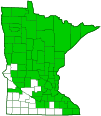harebell
(Campanula rotundifolia)
Conservation • Wetland • Description • Habitat • Ecology • Use • Distribution • Taxonomy
Description |
||
Harebell is a 4″ to 20″ tall, erect, perennial forb that rises from shallow roots and a slender rhizome. The stems are slender and erect to ascending. They do not recline on adjacent plants. They are unbranched except just below the inflorescence. They may be hairless or have inconspicuous longitudinal lines of hairs. When broken, the stem exudes a milky sap. Basal leaves are, broadly egg-shaped to nearly circular, 3 ⁄16″ to ⅜″ long, and 3 ⁄16″ to 5 ⁄16″ wide. They are on slender, ¾″ to 1¼″ long leaf stalks. They are shallowly heart-shaped, rounded, or broadly angled at the base and rounded or angled to a sharp point at the tip. The upper and lower surfaces are hairless. The margins are untoothed or have a few blunt teeth. Basal leaves are often absent at flowering time. The species name, rotundifolia, refers to the shape of the basal leaves. Stem leaves are alternate and ascending or spreading. Lower stem leaves are long-stalked, narrowly elliptic to narrowly inversely egg-shaped, and 1¼″ to 2⅜″ long. The upper and lower surfaces are hairless. The margins are untoothed. The leaves become progressively smaller, narrower, and shorter stalked as they ascend the stem. Upper stem leaves are stalkless and narrowly lance-shaped to linear. The inflorescence is a nodding, usually unbranched cluster (raceme) of 3 to 8 flowers at the end of the stem. The flowers are bell-shaped and ¾″ to 1¼″ long. There are 5 green sepals (calyx), fused at their base into a 1 ⁄16″ to ⅛″ long tube, then separated into 5 linear, ⅛″ to 3 ⁄16″ long lobes. The calyx lobes are widely spreading at maturity. There are 5 light blue to blue petals (corolla), fused at their base for about half of their length into a ¼″ to ⅜″ long tube, then separated into 5 lance-shaped, ⅛″ long lobes. The lobes of the corolla are much shorter than the tube and are flared outward. The calyx and corolla are each radially symmetrical so that if bisected vertically on any plane each half would be identical. There are 5 stamens that do not protrude from the corolla tube. There is a single violet style that ends in a stigma with 3 lobes. The style protrudes from the corolla tube but is not as long as the petals. The fruit is a nearly spherical, 3-chambered capsule containing many seeds. The capsule is ⅛″ to 3 ⁄16″ long, 1 ⁄16″ to ⅛″ in diameter. |
||
Height |
||
4″ to 20″ |
||
Flower Color |
||
Blue |
||
Similar Species |
||
Habitat |
||
Dry to moderate moisture. Woods, meadows, cliffs, and beaches. Full or partial sun. |
||
Ecology |
||
Flowering |
||
June to October |
||
Pests and Diseases |
||
|
||
Use |
||
|
||
Distribution |
||||
|
Sources |
|||
| 4/4/2022 | ||||
Nativity |
||||
Native |
||||
Occurrence |
||||
Common |
||||
Taxonomy |
|||
| Kingdom | Plantae (green algae and land plants) | ||
| Subkingdom | Viridiplantae (green plants) | ||
| Infrakingdom | Streptophyta (land plants and green algae) | ||
| Superdivision | Embryophyta (land plants) | ||
| Division | Tracheophyta (vascular plants) | ||
| Subdivision | Spermatophytina (seed plants) | ||
| Class | Magnoliopsida (flowering plants) | ||
| Superorder | Asteranae | ||
Order |
Asterales (sunflowers, bellflowers, fanflowers, and allies) | ||
Family |
Campanulaceae (bellflower) | ||
| Subfamily | Campanuloideae | ||
Genus |
Campanula (bellflowers) | ||
Subordinate Taxa |
|||
|
|||
Synonyms |
|||
Campanula alaskana Campanula dubia Campanula heterodoxa Campanula intercedens Campanula petiolata Campanula rotundifolia var. alaskana Campanula rotundifolia var. intercedens Campanula rotundifolia ssp. intercedens Campanula rotundifolia var. lancifolia Campanula rotundifolia var. petiolata Campanula rotundifolia var. velutina Campanula sacajaweana |
|||
Common Names |
|||
bluebell bluebell bellflower bluebell-of-Scotland harebell meadowbell roundleaf harebell |
|||
Glossary
Calyx
The group of outer floral leaves (sepals) below the petals, occasionally forming a tube.
Corolla
A collective name for all of the petals of a flower.
Linear
Long, straight, and narrow, with more or less parallel sides, like a blade of grass.
Raceme
An unbranched, elongated inflorescence with stalked flowers. The flowers mature from the bottom up.
Rhizome
A horizontal, usually underground stem. It serves as a reproductive structure, producing roots below and shoots above at the nodes.
Stamen
The male reproductive organ of a flower consisting of an pollen-producing anther on a supporting filament.
Stigma
The portion of the female part of the flower that is receptive to pollen.
Style
Part of the pistil, usually a slender stalk, connecting the ovary to the stigma(s).
Visitor Photos |
|||||
Share your photo of this plant. |
|||||
| This button not working for you? Simply email us at info@MinnesotaSeasons.com. Attach one or more photos and, if you like, a caption. |
|||||
Mike Fellows |
|||||
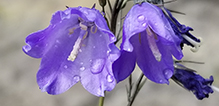 |
|||||
Alfredo Colon |
|||||
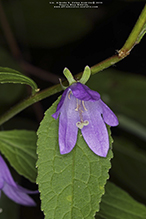 |
|||||
MinnesotaSeasons.com Photos |
|||||
Plant |
|||||
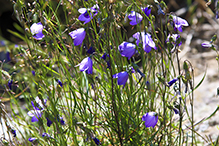 |
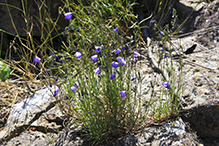 |
||||
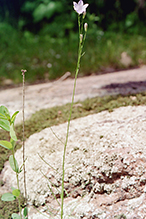 |
|||||
Inflorescence |
|||||
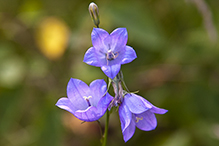 |
|||||
Flower |
|||||
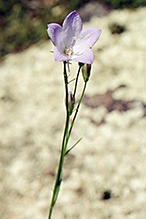 |
|||||

Slideshows |
||

Visitor Videos |
|||
Share your video of this plant. |
|||
| This button not working for you? Simply email us at info@MinnesotaSeasons.com. Attach a video, a YouTube link, or a cloud storage link. |
|||
Other Videos |
|||
| Common Harebell (Campanula rotundifolia) Wandering Sole TV |
|||
About
Published on Jul 14, 2012 Common Harebell on Sunflower Hill in British Columbia. Common Harebell is native to temperate regions of Great Britain, Northern Europe, and North America. |
|||
| Harebell (Campanula rotundifolia) PrairieMoonNursery |
|||
About
Uploaded on Jun 8, 2010 http://www.prairiemoon.com - Harebell also referred to as Bluebell Bellflower. It blooms at Prairie Moon Nursery in early June. |
|||

Visitor Sightings |
|||||
Report a sighting of this plant. |
|||||
| This button not working for you? Simply email us at info@MinnesotaSeasons.com. Be sure to include a location. |
|||||
| Mike Fellows 9/19/2020 |
Location: Butterwort Cliffs SNA |
||||
| Alfredo Colon 8/30/2019 |
Location: Woodbury, Minnesota |
 |
|||
MinnesotaSeasons.com Sightings |
|||||
Badoura Jack Pine Woodland SNA Blazing Star Prairie Addition Preserve, South Unit Carpenter St. Croix Valley Nature Center Cedar Creek Ecosystem Science Reserve Charles A. Lindbergh State Park Felton Prairie SNA, Bicentennial Unit Itasca Wilderness Sanctuary SNA Lake Alexander Woods SNA, South Unit Margherita Preserve-Audubon Prairie Minnesota Valley NWR, Louisville Swamp Unit Northern Tallgrass Prairie NWR, Pavia Unit Northern Tallgrass Prairie NWR, Rengstorf Unit Northern Tallgrass Prairie NWR, Spieker Unit Pankratz Memorial Prairie, North Unit Pembina Trail Preserve SNA, Crookston Prairie Unit Sand Prairie Wildlife Management and Environmental Education Area |
|||||

|
Created: Last Updated: © MinnesotaSeasons.com. All rights reserved. |
